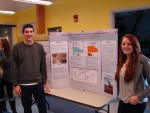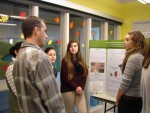Middle and High School students participating in the Mass Audubon’s “Salt Marsh Science Project” joined scientists and educators for the 18th annual Coastal Science Conference on Wednesday, November 19, at the Parker River National Wildlife Refuge. During the meeting, coastal scientists of all ages discussed strategies for tackling invasive species on salt marshes as part of the salt Marsh project, which is coordinated by Liz Duff, Education Representative for the Plum Island Ecosystem (PIE) Long Term Ecological Research (LTER) Program.
The annual symposium serves as the culmination of a season of student work, and thanks to the National Science Foundation’s Schoolyard LTER funds, students have used the opportunity to learn important science concepts while contributing to the conservation of important local ecosystems. For students who have dedicated their efforts to studying their local marsh, this conference is their opportunity to see how their efforts are connected to the work of other students at other sites, and to the larger context of efforts to protect and restore Massachusetts’ salt marshes. Students shared the results of this year's field experiences with oral presentations and poster displays. In addition, PIE LTER scientists Anne Giblin and Robert Buchsbaum served on a panel of scientists answering student questions about their profession and research.
“It’s exciting to see this project in its 18th year. It has become an integral part of local schools’ curriculum as new teachers pick up where retiring teachers have left off,” said Duff, who doubled as conference organizer. "There is a lot of excitement generated among the students when they meet their peers and professional scientists and learn from their work at this conference."
The continued participation of students in the Salt Marsh project supports long-term ecological research on Massachusetts’ salt marshes. Students have the opportunity to download and analyze up to 18 years of data from the project website at http://www.massaudubon.org/saltmarsh/ in addition to their own data.
Participants this fall included students from O’Maley School in Gloucester, Manchester Essex Regional High School, Rockport Middle School, Ipswich High School, Holton Richmond Middle School in Danvers, Rupert A. Nock Middle School in Newburyport, Essex Technical High School in Danver, and Endicott College.

 Enlarge this image
Enlarge this image
